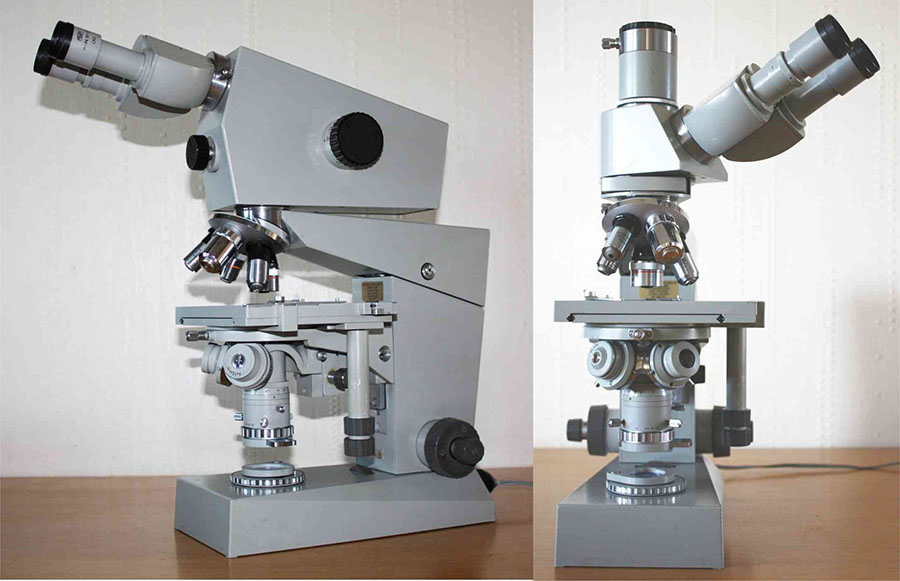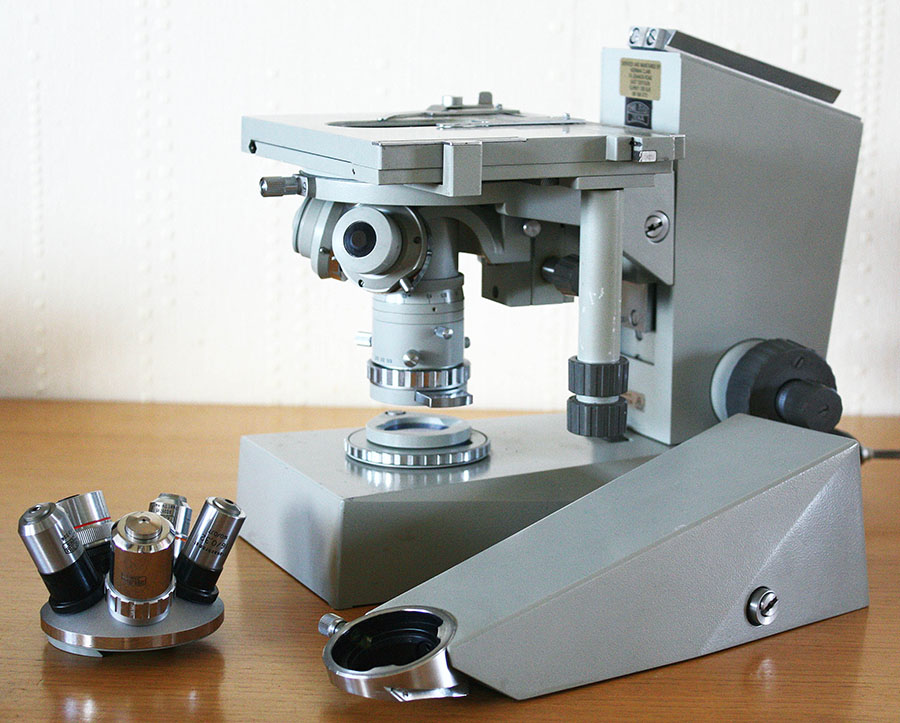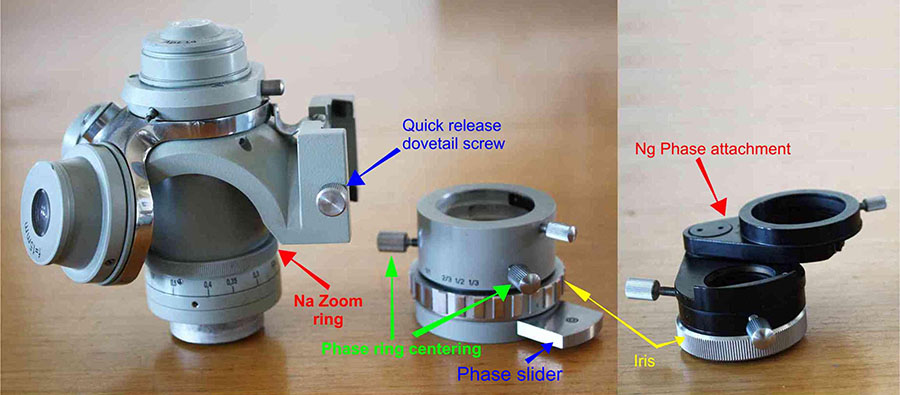
|
Carl Zeiss Jena Amplival Microscope by Raymond Sloss, UK |
Eastern block microscopes have often suffered from a reputation as 'second best'. No doubt this initially stemmed from the cold war prejudice's of the second half of the twentieth century. My experiences of microscopes from west, far east and the eastern block don't support this opinion. Among my far too large collection of microscopes I have many examples from all of these sources. The Amplival is typical of products that were produced by the Jena based Zeiss factory before the disappearance of the 'Iron Curtain'. This model followed the famous line of black microscopes manufactured before and after WWII, typified towards the end by the Jena Ng, described in an earlier Micscape article by René van Wezel.
The one problem that contributed more than anything to the reputation of East German and Russian made microscopes was the grease. After only a few years this would stiffen and often solidify completely. This fact made the instruments useless without prohibitively expensive renovation and often put them cheaply and conveniently on the amateur market. I have had an Ng for some years and for some time had an 'Ergaval', a more student/routine orientated version of the Amplival. A few weeks ago an Amplival appeared on eBay with a very modest 'Buy it Now' and I jumped in with both feet. After a hundred mile round trip to pick it up I wasn't surprised to find virtually every feature from focussing to irises seized solid. The only amusing thing about seized microscopes is that they always seem to have the service company's sticker with a recent date! Anyway, a couple of morning's work and everything worked like new. I tend to use greases which I know from engineering experience rather than anything recommended by manufacturers, it's easier, cheaper, and they seem to work just as well. I suspect my Amplival was almost unused as it is in virtually pristine condition.

The Amplival was a very complete system, every aspect of light microscopy was available including Fluorescence and DIC. The following links are to factory catalogues of the time (around the mid 70’s, in German only), the illustrations showing some of the model's versatility.
http://www.mikroskop-online.de/Mikroskop%20BDA/30-047d-1%20%20AMPLIVAL.pdf
http://www.mikroskop-online.de/Mikroskop%20BDA/30-048b.G%20%20AMPLIVAL%20(B).pdf

The photo shows the modular nature of the microscope, as well as the high quality of the engineering. One screw removes complete units which are precisely located with large dovetails. The modular idea was later further developed in their excellent 'Jena' series infinity research microscopes. The modularity did not detract from rigidity. Examination of a high power immersion image while applying finger pressure to the stage or limb produces far less effect than a similar action on a Zeiss West microscope of the same period (apart from the PM series limb!). The Amplival has the 6 volt tungsten lighting typical of the period, adequate for B/F and phase, just good enough for na 1.0 immersion darkfield. The special screwthreaded lamps are expensive and I have an LED alternative. The base of the microscope also incorporates a flip out frosted filter and a field iris. The Amplival shares the same head fitting bayonet as most Eastern Block microscopes: Meopta/Lomo/Biolam etc. The trinocular head shown is an interesting design in that pushing it to the side (with a click stop) removes the prism and gives a straight through light path for the camera. It also has an internal hole for the relay photo eyepiece.
I have had the Jena zoom head shown in the first photo in my collection for a few years. It is designed to work with x8 eyepieces. The zoom knob then produces a constantly variable range of eyepiece powers from x6.3 – x25. This is useful for quickly enlarging the image to check a detail, but like all zooms and Optovars, although of superb quality, it is capable of producing plenty of 'empty' magnification! One odd result of its use is a laterally inverted 'mirror' image. It also incorporates a retractable, focussing Bertrand lens, operated by the front knob, very convenient for setting the condenser iris and aligning phase rings.
Jena objectives of this period are commonly found as: x3.2, x6.3, x10, x16, x40 and x100, often planachros. The objectives are 45mm DIN and generally very good, especially some of the Apo's. My Amplival is shown in the photos with a mix of Zeiss east and west objectives — as usual I was experimenting. I have several pairs of x10 and x12.5 high eyepoint widefield eyepieces which make use of the microscope very restful.

One of the most fascinating features of the Jena microscopes of this period is the aplanatic zoom/pancratic condenser with three heads on a turret. I have one on my Ng as well as the Amplival. The condenser is constantly zoomable between na 1.4 and na 0.16 with fifteen marked intermediate positions. The turret has three heads, an aplanatic B/F, a 15mm low power B/F and an immersion darkfield.
One of the most fascinating features of the Jena microscopes of this period is the aplanatic zoom/pancratic condenser with three heads on a turret. I have one on my Ng as well as the Amplival. The condenser is constantly zoomable between na 1.4 and na 0.16 with fifteen marked intermediate positions. The turret has three heads, an aplanatic B/F, an immersion darkfield and a 15mm low power B/F, the top element of which slides out for illumination of objectives less than about x6.3.
The use of the condenser may seem obvious, in practice it is less so. Setting the numerical aperture to the aperture of the objective gives a slightly less satisfactory image than trimming a slightly wider aperture with the iris. Every adjustment seems to bring a change in the apparent size and focus of the field iris. The result is a feeling of fussiness and impracticality about objective changing. This is compounded by the fact that the condenser assembly has to be lowered a long way down before a new turret head can be swung into position. All three turret mounted condenser heads are centerable, the condenser itself is not achromatic.
The Zeiss Jena solution to phase contrast was slightly different to most other makers. They did produce the typical rotating disc condenser with several apertures, one with iris for B/F, and others with phase rings for different objective powers. The Jena difference was that in later versions of the condenser, phase plates had three rings and the objectives had two. I have failed to find a document with an explanation of the reason for this system, it does seem to limit the bright halos of specimen edges found on more conventional systems. Certainly the halos are less obvious than those in my Zeiss West and Wild systems. It is at this point that the pancratic condenser comes into its own, only one phase plate is needed. The photo shows a captive slider at the base of the condenser. This has one clear aperture and one three ring phase plate, this can be centered with two knurled screws. The zoom allows the phase plate to work with any of the phase objectives. According to the German instructions, simply set the condenser to the aperture of the objective and check the centering of the phase rings. Apart from the conventional phase image, adjusting the aperture and the height of the condenser produces a variety of phase effects. The Amplival phase attachment differs from that of the earlier Ng. Both attachments are removable as a whole unit but the phase plate in the Ng version had to be swung out with the iris. The Ng had an additional off-settable iris in the base for oblique illumination.
Despite some reservations above, I like the microscope very much. In use it has a feeling of quality and versatility. The zoom condenser makes every setup fairly tricky, quite the reverse of expectation, but the variety of illumination effects it makes possible are well worth the effort.
Comments to the author, Raymond Sloss are welcomed.
Published in the January 2009 edition of Micscape Magazine.
Please report any Web problems or offer general comments to the Micscape Editor.
Micscape is the on-line monthly magazine of
the Microscopy UK web
site at Microscopy-UK.